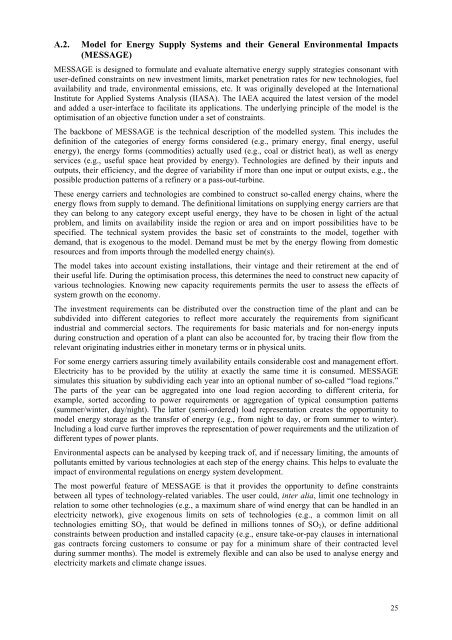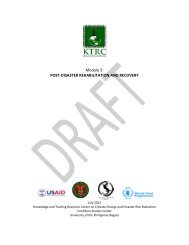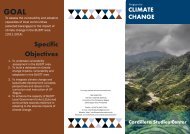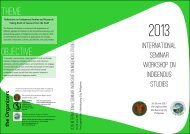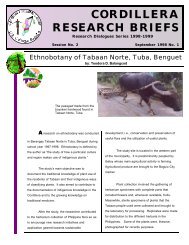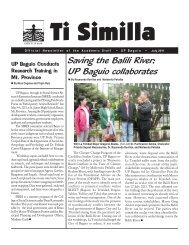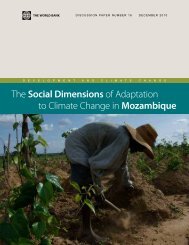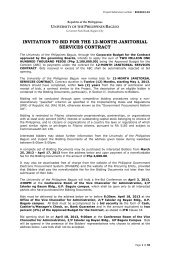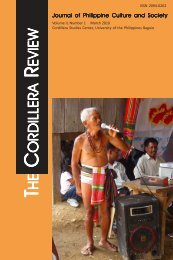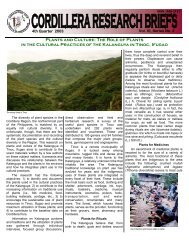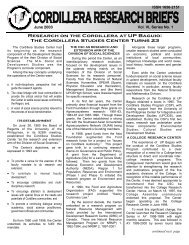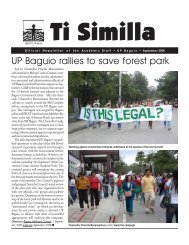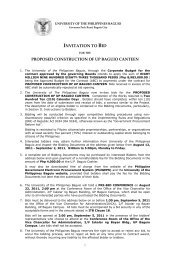Ghana - UNEP
Ghana - UNEP
Ghana - UNEP
- No tags were found...
You also want an ePaper? Increase the reach of your titles
YUMPU automatically turns print PDFs into web optimized ePapers that Google loves.
A.2.Model for Energy Supply Systems and their General Environmental Impacts(MESSAGE)MESSAGE is designed to formulate and evaluate alternative energy supply strategies consonant withuser-defined constraints on new investment limits, market penetration rates for new technologies, fuelavailability and trade, environmental emissions, etc. It was originally developed at the InternationalInstitute for Applied Systems Analysis (IIASA). The IAEA acquired the latest version of the modeland added a user-interface to facilitate its applications. The underlying principle of the model is theoptimisation of an objective function under a set of constraints.The backbone of MESSAGE is the technical description of the modelled system. This includes thedefinition of the categories of energy forms considered (e.g., primary energy, final energy, usefulenergy), the energy forms (commodities) actually used (e.g., coal or district heat), as well as energyservices (e.g., useful space heat provided by energy). Technologies are defined by their inputs andoutputs, their efficiency, and the degree of variability if more than one input or output exists, e.g., thepossible production patterns of a refinery or a pass-out-turbine.These energy carriers and technologies are combined to construct so-called energy chains, where theenergy flows from supply to demand. The definitional limitations on supplying energy carriers are thatthey can belong to any category except useful energy, they have to be chosen in light of the actualproblem, and limits on availability inside the region or area and on import possibilities have to bespecified. The technical system provides the basic set of constraints to the model, together withdemand, that is exogenous to the model. Demand must be met by the energy flowing from domesticresources and from imports through the modelled energy chain(s).The model takes into account existing installations, their vintage and their retirement at the end oftheir useful life. During the optimisation process, this determines the need to construct new capacity ofvarious technologies. Knowing new capacity requirements permits the user to assess the effects ofsystem growth on the economy.The investment requirements can be distributed over the construction time of the plant and can besubdivided into different categories to reflect more accurately the requirements from significantindustrial and commercial sectors. The requirements for basic materials and for non-energy inputsduring construction and operation of a plant can also be accounted for, by tracing their flow from therelevant originating industries either in monetary terms or in physical units.For some energy carriers assuring timely availability entails considerable cost and management effort.Electricity has to be provided by the utility at exactly the same time it is consumed. MESSAGEsimulates this situation by subdividing each year into an optional number of so-called “load regions.”The parts of the year can be aggregated into one load region according to different criteria, forexample, sorted according to power requirements or aggregation of typical consumption patterns(summer/winter, day/night). The latter (semi-ordered) load representation creates the opportunity tomodel energy storage as the transfer of energy (e.g., from night to day, or from summer to winter).Including a load curve further improves the representation of power requirements and the utilization ofdifferent types of power plants.Environmental aspects can be analysed by keeping track of, and if necessary limiting, the amounts ofpollutants emitted by various technologies at each step of the energy chains. This helps to evaluate theimpact of environmental regulations on energy system development.The most powerful feature of MESSAGE is that it provides the opportunity to define constraintsbetween all types of technology-related variables. The user could, inter alia, limit one technology inrelation to some other technologies (e.g., a maximum share of wind energy that can be handled in anelectricity network), give exogenous limits on sets of technologies (e.g., a common limit on alltechnologies emitting SO 2 , that would be defined in millions tonnes of SO 2 ), or define additionalconstraints between production and installed capacity (e.g., ensure take-or-pay clauses in internationalgas contracts forcing customers to consume or pay for a minimum share of their contracted levelduring summer months). The model is extremely flexible and can also be used to analyse energy andelectricity markets and climate change issues.25


